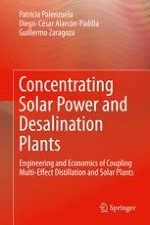2015 | OriginalPaper | Chapter
5. Integration of a Desalination Plant into a Concentrating Solar Power Plant
Authors : Patricia Palenzuela, Diego-César Alarcón-Padilla, Guillermo Zaragoza
Published in: Concentrating Solar Power and Desalination Plants
Publisher: Springer International Publishing
Activate our intelligent search to find suitable subject content or patents.
Select sections of text to find matching patents with Artificial Intelligence. powered by
Select sections of text to find additional relevant content using AI-assisted search. powered by
